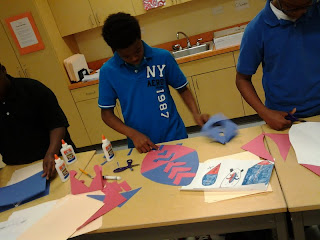Traditional Zulu shields date back to King Shaka Zulu and have been used by Zulu tribesman in battle for hundreds of years. As the modern world has evolved so to has the Zulu tribesman and with this the Zulu shield is no longer used in battle and is now used for traditional Zulu ceremonies such as weddings and funerals.
Zulu tribe shields of the Zulu peoples of southern Africa have a variety of traditional functions and designs. They are are also commercially available and sought after as collectors' items or for decoration.
Projects for Zulu tribe shields are most effective when they inform people of the role, meaning or history of the shields. Different sizes and designs have different meanings. With some research and work, you can make a Zulu shield project to meet your specific goals. The objective for
designing a Zulu Shield is for students to conduct internet research of the history of 5 types of prominent Zulu shields (as seen above) which are each used for different occasions:
Ø 1 - Isihlangu - The large battle shield used by King Shaka Zulu. This is about 5ft in size (1.5m)
Ø Umbumbuluzo - The small battle shield that could easily be held in one hand when attacking
Ø Ihubelo - A small courting shield often this is died a red color
Ø Igqoka - A small dancing shield that is used at traditional Ceremonies
Ø Ihawu - A difficult rare shield to find.
In addition, students will research the ascent and innovations of Shaka,weapons and shields, The first challenge of Europe: African impi versus the Boer Commando and The second challenge of Europe: African impi versus the British Empire. Students will then draw 3 thumbnail sketches depicting shield designs of their own. From that point students will construct a 3 dimensional Zulu Shield from construction paper with heavy weight drawing paper as a backing (as seen above and below).
The Zulu impi is popularly identified with the ascent of Shaka (also rendered T'chaka), ruler of the relatively small Zulu tribe before its explosion across the landscape of southern Africa, but its earliest shape as a purposeful instrument of statecraft lies in the innovations of the Mwetha chieftain Dingiswayo, according to some historians (Morris 1965).
These innovations in turn drew upon existing tribal customs, such as the iNtanga. This was an age grade traditions common among many of the Bantu peoples of the continent's southern region. Youths were organized into age groups, with each cohort responsible for certain duties and tribal ceremonies.
Zulu shields have played a vital role in the traditional Zulu's battles and have always been handcrafted from cowhide or more commonly known in Zulu terms as Nguni cattle. Nguni cattle are native to Southern Africa and play an important role in the daily living of the Zulu people. Nguni cattle are a currency in Zulu traditions and will determine the wealth of a Zulu man by the cows he has. When a young man intends to wed, he has to first pay the father of the bride a set amount of cattle agreed between them before he can have her hand in marriage
All warriors carried a shield made of oxhide, which retained the hair, with a central stiffening shaft of wood, the mgobo. Shields were the property of the king; they were stored in specialised structures, raised off the ground for protection from vermin, when not issued to the relevant regiment. The large isihlangu shield of Shaka's day was about five feet in length and was later partially replaced by the smaller umbumbuluzo, a shield of identical manufacture but around three and a half feet in length. Close combat relied on co-ordinated use of the iklwa and shield. The warrior sought to get the edge of his shield behind the edge of his enemy's, so that he could pull the enemy's shield to the side thus opening him to a thrust with the iklwa deep into the abdomen or chest.
Resources:
Impi: Armed Body of Men
History of the Zulu Shield
Zulu Culture




